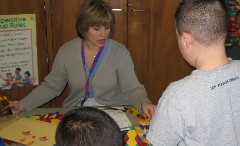

Intervention Strategies
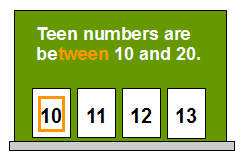
Featured Topic: Teen Numbers
It is very common for students to have difficulty with the numbers 11- 19. Their names do not follow the common rule and they are the sight words/ numbers of mathematics. Teachers must ACTIVELY help students develop meaning for both the words and the corresponding numerals. It may help to emphasize that the teen numbers are between 10 and 20.
Do some informal assessment to decide where to begin on this continuum:
Rote Counting:
- Identify the student's comfort zone: add 1-2 numbers at a time to the 1-10 sequence until the student can reliably count on using the correct names.
- Sing songs and extend counting songs: for example, Ten Little Indians can be modified and extended to be 11 little, 12 little, 13 little teddy bears (or dinosaurs or valentines, etc.). Singing is great reinforcement for many students and helps them acquire fluency with these extended numbers more easily than simply counting aloud.
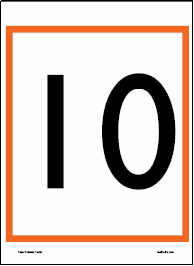
- Who Has The Number?: Give students the large
 demo-size cards (#10-20) and have them hold up the cards as you sing the song so that students hear and see the numbers.
demo-size cards (#10-20) and have them hold up the cards as you sing the song so that students hear and see the numbers.
- Teen Line-up: distribute the large
 demo-size cards (#10-20) and ask students to line up in the correct order. NOTE: numbers 10 and 20 of the teen demo cards are boxed in bright orange [see picture at left] to visually reinforce the notion that the teen numbers are between 10 and 20. Reinforce this notion often when working with the teen demo cards.
demo-size cards (#10-20) and ask students to line up in the correct order. NOTE: numbers 10 and 20 of the teen demo cards are boxed in bright orange [see picture at left] to visually reinforce the notion that the teen numbers are between 10 and 20. Reinforce this notion often when working with the teen demo cards.
- Build the Hundred Board: students need to build the hundred board by placing the or tiles in the correct order. Again, build slowly by varying the number of tiles the student uses to match the individual comfort zone of each student. Alternatively, print out
 small number cards, attach magnetic tape, and use heaters, sides of file cabinets or cookie sheets so that students can build the hundred chart with these number cards.
small number cards, attach magnetic tape, and use heaters, sides of file cabinets or cookie sheets so that students can build the hundred chart with these number cards.
- Classroom Applications: Have student perform classroom duties which support the development of one-to-one correspondence: attendance head count, passing out/collecting papers, paper plates, napkins, etc.
Attaching meaning to the number:
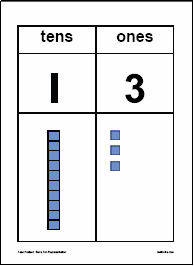
- Four-handed Teens: Have student pairs represent teen numbers. One student holds up both hands to represent 10 fingers. The other student shows additional fingers to represent the teen number.
- Stamping sets: Give student number cards and have student stamp that many objects on the card.
- Teen Number Posters: Hang
 number posters for numbers 11-20 on classroom walls. These posters include the base-ten representation of each number. Regularly include these in rote counting activities, counting 1-20 while pointing to the posters. Introduce the teen numbers as between 10 and 20.
number posters for numbers 11-20 on classroom walls. These posters include the base-ten representation of each number. Regularly include these in rote counting activities, counting 1-20 while pointing to the posters. Introduce the teen numbers as between 10 and 20.
- Teen Number Mats: Provide number card mats for each number 11-19 and have students count aloud as they place counters on the mat. (Modification would be providing dots on which students place the counters as they count aloud.) NOTE: There is no effort to group materials or make tens at this stage. Students are simply attaching rote counting to one-to-one correspondence and the beginning of number recognition.
Learning to group and make bundles of tens

- Teen Bundles: Use non-grouped manipulatives (such as straws and craft sticks) which can be bundled with rubber bands. Provide a
 place-value mat with the tens and ones labels. Have students move the bundle of ten to the tens side. Students should record how many tens they have and how many ones they have. Students should read the number.
place-value mat with the tens and ones labels. Have students move the bundle of ten to the tens side. Students should record how many tens they have and how many ones they have. Students should read the number.
- Introduce linking cubes: sticks of 10 cubes and move the stick to the tens column on their
 place value mats. This is the concrete preparation for using the base-ten blocks which are pregrouped and donít meet studentsí concrete need to bundle or group 10 objects to build number sense for place value in our base-ten system.
place value mats. This is the concrete preparation for using the base-ten blocks which are pregrouped and donít meet studentsí concrete need to bundle or group 10 objects to build number sense for place value in our base-ten system.
- Math Center: Provide baggies of different numbers of materials and
 place-value mats in the math center so that students can practice counting, making tens and then writing the numbers.
place-value mats in the math center so that students can practice counting, making tens and then writing the numbers.
- Classroom Applications: The
 School Day Count routine provides many opportunities to bundle groups of ten straws. Be sure to have struggling students actively involved in this classroom job. Sing a
School Day Count routine provides many opportunities to bundle groups of ten straws. Be sure to have struggling students actively involved in this classroom job. Sing a  Bundle Song to reinforce the mathematical importance of this concept. Routinely ask students how many more days until we make a bundle, etc. to motivate students to think in terms of groups of 10.
Bundle Song to reinforce the mathematical importance of this concept. Routinely ask students how many more days until we make a bundle, etc. to motivate students to think in terms of groups of 10.
Learning to model numbers with base-ten blocks
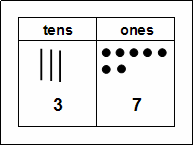
- Use of Base-Ten Blocks: This should follow lots of practice with non-grouped materials and students should use base-ten blocks and a
 place-value mat concretely, writing only the answer to modeling the numbers to attach meaning to how many ones and how many tens they have.
place-value mat concretely, writing only the answer to modeling the numbers to attach meaning to how many ones and how many tens they have.
- Pictorial Representation: Be sure to model for students how they can use simple lines and dots to represent the base-ten blocks to record their thinking. This semi-concrete step is often skipped when teachers go from concrete (base-ten blocks) to abstract (numbers on a page). Students who use this pictorial step have access to more powerful mathematical reasoning by using this intermediate step to think through problems beyond what they have learned.
- Overhead practice: after students have had lots of hands-on experience, use an overhead to present either the blocks alone or the number alone and ask students to quickly model the number on their
 place-value mats, filling in the missing information.
place-value mats, filling in the missing information.
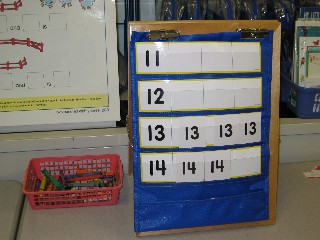
Learning to recognize the teen numbers
- Matching Station: Provide many copies of the teen number cards for students to match to teen numbers in sequential order.
- Matching Sing-along: As students sing extended teen number songs, have students point to teen number cards to imprint written number with the oral name.
- Teen Line-Up: students shuffle number cards, then place them in sequential order. After this, students point to each number and name it.
- Teen Swiper: One student places the teen numbers in sequential order on the floor then removes a card while the other student has eyes closed. This student opens eyes and names the missing number. He/she must then locate that number in a second pile of all teen numbers and place it in the correct place. For this game, it is helpful to have two decks printed on different color paper, or in different color fonts for easy separation into two complete decks.
Quick Assessments:
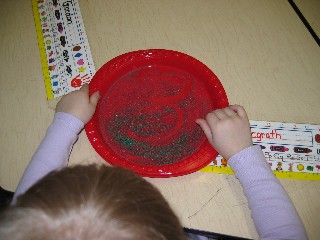
- What Number Am I?: Show students a number you have built with individual straws and bundles of straws on the place-value mat. Ask student to write how many tens and ones. Ask student to read the number.
- Show Me: provide several single straws and several bundles of ten. Ask students to model numbers and see if he/she selects the appropriate materials or has to count individual straws to build the number.
- Teen Scrambled Eggs: Provide a cookie sheet with scrambled teen numbers. Ask student to unscramble the numbers and place them in the correct order. Once this is completed, ask student to point to each card and say the number. Check student number recognition by pointing to random cards out of sequence.
- Sand Tray Numbers: Ask student to write the number in the sand tray, as pictured to the right.
Games for Practice
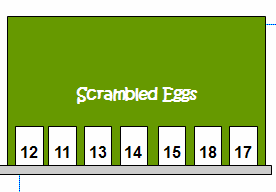
Teen Scrambled Eggs
Place the number cards on the chalk-ledge or on the rug with two numbers switched. Ask students which numbers are the scrambled eggs and need to be switched. You can also have students hold some of the demo cards and then scramble two students while the rest close their eyes. After they open their eyes, ask them to figure out which numbers are the scrambled eggs. After this introduction, students may pair-play Teen Scrambled Eggs, as described above.
- Download
 Demo Teen Numbers.
Demo Teen Numbers.

